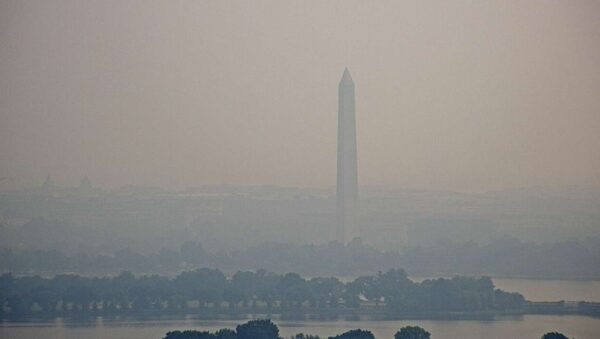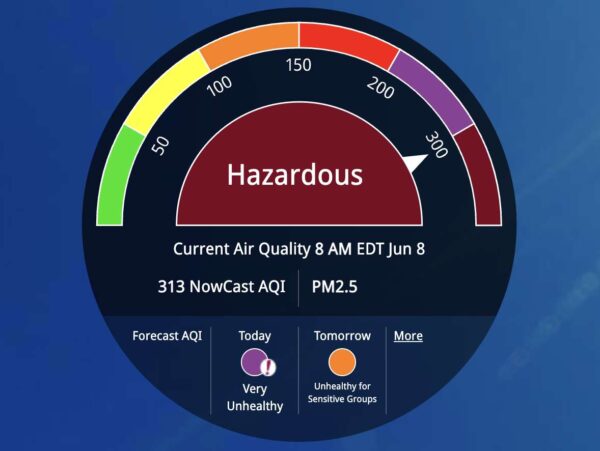
The air quality in Arlington has reached the worst level on the scale — “hazardous.”
As of 9 a.m. the federal government website AirNow says Arlington’s AQI, or air quality index, is 313. That puts the county in “Code Maroon” territory, two levels above the more commonly known Code Red.
“Everyone should stay indoors and reduce activity levels,” the website says. Anyone who must be outside today is being encouraged to wear a high quality mask.
Arlington Public Schools, the county parks department and the Arlington Soccer Association — among others — have cancelled all outdoor activities Thursday. Meanwhile, the FAA says that air traffic at D.C. airports may be impacted by the low visibility.
Reduced visibility from wildfire smoke will continue to impact air travel today. We will likely need to take steps to manage the flow of traffic safely into New York City, DC, Philadelphia and Charlotte.
Follow us here for major updates & monitor https://t.co/smgdqJN3td.
— The FAA ✈️ (@FAANews) June 8, 2023
Cameras in Pentagon City show D.C. barely visible through the haze this morning. A rancid campfire-like smell is pervasive throughout the area.
Yesterday, I showed you Code Red. Today, it's a view of Code Purple & Maroon! Where I could make out the monuments across the Potomac yesterday, now the river's completely obscured & it's hard to see the Pentagon just across I-395.@capitalweather @ARLnowDOTcom #WildfireSmoke pic.twitter.com/Og5SJK2V7C
— Dave Statter (@STATter911) June 8, 2023
Despite the apocalyptic scene outside this morning, the good news is that some relief is on the way. The National Weather Service says a front is expected to enter the area tomorrow, clearing out some of the smoke.
Tomorrow the air quality for the D.C. region is expected to largely be at “Code Orange” levels, with an average AQI just above 100.

Update at 10:20 a.m. — The National Weather Service just issued the following Special Weather Statement, suggesting that even thicker smoke may be on the way, before conditions gradually improve.
…POOR AIR QUALITY IN THE MID-ATLANTIC THROUGH FRIDAY DUE TO CANADIAN WILDFIRES…
Due to Canadian wildfires, smoke is prevalent in the Mid-Atlantic region, including the greater Baltimore and Washington metropolitan areas. Under northerly winds, smoke will continue to be pushed south over our area. Thicker smoke will continue to overspread portions of the area, resulting in poor air quality and visibility potentially less than 1 mile. Some improvement is likely through the day, but the smoke likely will continue to affect the area at times until a front on Friday potentially brings some reprieve to fine particle concentrations.
Depending on your location, Air Quality will vary, with much of the area either Code Orange or Code Red through the day today. There is a Code Purple Air Quality Alert for the District of Columbia.
A Code Orange Air Quality Alert means that air pollution concentrations within the region are unhealthy for sensitive groups. Sensitive groups include children, people with heart or lung disease, older adults, pregnant people, and those that spend a lot of time outdoors.
Some areas may see Code Red, which means “unhealthy for the general population.” If you are under a Code Red Air Quality Alert, everyone should keep outdoor activities light and short. For those people in sensitive groups, consider moving all activities indoors.
A Code Purple Air Quality Alert means that everyone may experience more serious heath effects and should avoid outdoor activities, especially individuals with heart and breathing ailments, children, and older adults.
The effects of air pollution on people can be minimized by avoiding strenuous outdoor activity or exercising indoors. Go indoors if you have symptoms.
Update at 11 a.m. — This is now officially the first Code Purple air quality day for fine particle pollution, according to the Metropolitan Washington Council of Governments.
The Metropolitan Washington Council of Governments (COG) has issued a Code Purple Air Quality Health Advisory for the metropolitan Washington region. Current air quality conditions have reached Code Purple, very unhealthy levels for everyone, for fine particle pollution due to ongoing smoke from fires in Canada. The air quality forecast for June 8 has been updated to Code Purple.
COG shares the following health precautions from EPA:
- Sensitive groups (including children, older adults, and people with heart or lung disease): Avoid all physical activity outdoors. Reschedule to a time when air quality is better or move activities indoors.*
- Everyone else: Avoid long or intense activities. Consider rescheduling or moving activities indoors.*
The D.C. region has not previously recorded a Code Purple day for fine particle pollution. In 2012, the region recorded two days for ozone pollution that would qualify as Code Purple by the current 2015 standards.
Photo via WeatherBug

